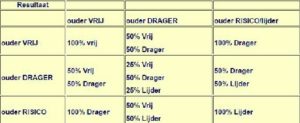What is Degenerative Myelopathy?
Degenerative myelopathy is a progressive disease of the spinal cord in older dogs. The disease has an insidious onset typically between 8 and 14 years of age. It begins with a loss of coordination (ataxia) in the hind limbs. The affected dog will wobble when walking, knuckle over or drag the feet. This can first occur in one hind limb and then affect the other. As the disease progresses, the limbs become weak and the dog begins to buckle and has difficulty standing. The weakness gets progressively worse until the dog is unable to walk. The clinical course can range from 6 months to 1 year before dogs become paraplegic. If signs progress for a longer period of time, loss of urinary and fecal continence may occur and eventually weakness will develop in the front limbs. Another key feature of DM is that it is not a painful disease.
Affected brain
Degenerative myelopathy is a devastating disease causing progressive paralysis in a large number of dog breeds. New research has identified a gene that is associated with a major increase in risk of the disease.
What causes Degenerative Myelopathy?
Degenerative myelopathy begins with the spinal cord in the thoracic (chest) region. If we look under the microscope at that area of the cord from a dog that has died from DM, we see degeneration of the white matter of the spinal cord. The white matter contains fibers that transmit movement commands from the brain to the limbs and sensory information from the limbs to the brain.
DM vs Normal
In the section of a spinal cord from a dog who has died of DM (Left), the degeneration is seen as a loss of the blue color at the edges (arrows) compared with the spinal cord from a normal dog which is blue througout (Right).
This degeneration consists of both demyelination (stripping away the insulation of these fibers) and axonal loss (loss of the actual fibers), and interferes with the communication between the brain and limbs. Recent research has identified a mutation in a gene that confers a greatly increased risk of developing the disease.
How is degenerative myelopathy clinically diagnosed?
Degenerative myelopathy is a diagnosis of elimination. We look for other causes of the weakness using diagnostic tests like myelography and MRI. When we have ruled them out, we end up with a presumptive diagnosis of DM. The only way to confirm the diagnosis is to examine the spinal cord under the microscope when a necropsy (autopsy) is performed. There are degenerative changes in the spinal cord characteristic for DM and not typical for some other spinal cord disease.
What else can look like degenerative myelopathy?
Any disease that affects the dog’s spinal cord can cause similar signs of loss of coordination and weakness. Since many of these diseases can be treated effectively, it is important to pursue the necessary tests to be sure that the dog doesn’t have one of these diseases. The most common cause of hind limb weakness is herniated intervertebral disks. The disks are shock absorbers between the vertebrae in the back. When herniated, they can cause pressure on the spinal cord and weakness or paralysis. Short-legged, long back dogs are prone to slipped disks. A herniated disk can usually be detected with X-rays of the spine and myelogram or by using more advanced imaging such as CT scan or MRI. Other diseases we should consider include tumors, cysts, infections, injuries and stroke. Similar diagnostic procedures will help to diagnose most of these diseases. If necessary, your veterinarian can refer you to a board certified neurologist who can aid in diagnosing degenerative myelopathy. A directory to a neurologist near you can be found at American College of Veterinary Internal Medicine website under the “Find a Specialist Near You” link.
How do we treat degenerative myelopathy?
There are no treatments that have been clearly shown to stop or slow progression of DM. Although there are a number of approaches that have been tried or recommended on the internet, no scientific evidence exists that they work. The outlook for a dog with DM is still grave. The discovery of a gene that identifies dogs at risk for developing degenerative myelopathy could pave the way for therapeutic trials to prevent the disease from developing. Meanwhile, the quality of life of an affected dog can be improved by measures such as good nursing care, physical rehabilitation, pressure sore prevention, monitoring for urinary infections, and ways to increase mobility through use of harnesses and carts.
Precautionary measures
It is important to test every dog that is used for breeding on DM.
There are three possible results:
* Free – Means that the dog is free of this gene mutation
* Carrier – Carriers can spread the mutation in the population without having the symptoms themselves.
* Sufferers – Sufferers run the risk of developing the disease, but that does not always happen
If we decided to breed only with DM free dogs, this will eventually lead to a narrowing of the breeding base. This makes it increasingly difficult to make combinations in which there is little or no relationship between the two parent animals and inbreeding is a fact.
For this reason they bred with carriers. There is also occasionally bred with sufferers when this dog is valuable for the breed in terms of its bloodlines. This is a good example of “broad breeding”. However, one of the two parents must always be free of DM.


